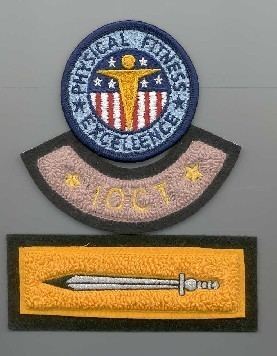Location(s) Hayes Gym, USMA | Inaugurated 1944 | |
 | ||
Date(s) periodically throughout the year, primary test is in February | ||
The Indoor Obstacle Course Test (IOCT) is a test of full-body functional physical fitness administered by the Department of Physical Education (DPE) at the United States Military Academy at West Point, NY. DPE considers the IOCT to be one of the best evaluations of total body fitness given in the Army. Cadets who earn an A- (2:38 or less for males and 3:35 or less for females) are authorized to wear the IOCT Badge on their athletic shorts.
Contents
Description
DPE administers the test in historic Hayes Gymnasium, built in 1910. The IOCT is similar in concept to the obstacle course seen on the TV show American Gladiators, with the addition of a quarter mile sprint at the conclusion of the course. DPE administers the IOCT in the winter months, usually in early February. Large crowds of cadets, officers, and other onlookers gather to watch. Due to the extreme intensity of the event, cadets sometimes become nauseous and vomit shortly after completion, while many cadets take hours to fully recover from coughing and wheezing afterward. This wheezing is said to be the "Arvin Black Lung" or "Hayes Lung".
Relevance
Army Regulation 350-1, Army Training and Leader Development, [1] specifically supports functional fitness and the IOCT by specifically naming numerous skill related components of fitness, like balance, agility, and coordination by stating "Preparation for the APFT is of secondary importance. Maintenance of the military skills listed below will also be emphasized."
The IOCT is often cited or studied in articles concerning high intensity human performance and obstacle courses. This is due to the large amount of available data due to the lengthy history of the course. It has been administered with few changes since 1944.
Test Sequence
The test consists of 11 events performed sequentially: low crawl under barrier, tire footwork, two-handed vault, 8 ft horizontal shelf, horizontal bar navigation, hanging tire, balance beam, 8 ft horizontal wall, 20 ft horizontal ladder, 16 ft vertical rope, and 350m sprint (carrying a 6 lb medicine ball for the first 120m, a baton for the second 120m, and empty-handed for the remaining 110m). Because of the unique level of athletic skill needed to pass the test and the tremendous level of effort needed to excel at it, the IOCT holds a special place in the hearts of all West Point Cadets and graduates. A search of YouTube will return many videos about it, both serious and comical. The IOCT is both feared and revered by the members of the Long Gray Line and is seen as a link between graduates of long ago and cadets of today.
History
DPE began administering the IOCT in 1944 during the Second World War. After lessons learned from WWII, the IOCT was changed to obstacles that are similar to what we see today. The test has changed little since 1948.
Gender Difference
The difference in completion time grade scales between male and female cadets is not taken into account during the order of merit listing that the United States Military Academy uses for branch and post selections for cadets.
